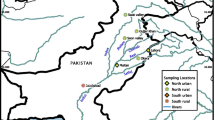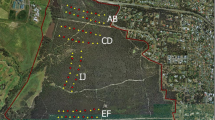Abstract
House crows, Corvus splendens, are highly successful emigrants from the Indian subcontinent that have colonized urban and rural habitats in many locations in Asia. We conducted counts of crows, recorded sound intensities (db) and used a Likert scale to score cleanliness, traffic, trees, and people along 500 m transects in three residential, park and business areas in three urban and rural landscapes respectively, in Selangor and Perak, Malaysia to determine the use of rural and urban landscapes by crows. Significantly more crows were recorded in urban than rural landscapes (p = 0.016), and in business than park areas in both urban and rural sites (p < 0.001). In urban landscapes they were of similar abundance in business and residential areas at two sites but not the third (p < 0.001). The availability of rubbish (primarily food scraps) was the most important factor explaining 68 % of C. splendens abundance and this was consistent with gut analysis of carcasses obtained from council culls. These results suggest that crow management would benefit from cleanliness around business areas in particular.



Similar content being viewed by others
References
Akram N, Khan HA, Javed M (2013) Inhibiting the house crow (Corvus splendens) damage on maize growth stages with reflecting ribbons in a farmland. J Animal Plant Sci 23(1):182–189
Bomford M, Sinclair R (2002) Australian research on bird pests: impact, management and future directions. Emu 102:29–45
Chia PK (1976) Some aspects of the natural history of the house crow Corvus splendens Vieillot in Kuala Lumpur. Unpublished honour’s thesis, University of Malaya, Malaysia 27 pp
Davidson GWH (1979) Kuala Lumpur and her crows. Malayan Naturalist Jan 23–25
DeGraaf RM, Wentworth JM (1986) Avian guild structure and habitat association in suburban bird communities. Urban Ecol 9:399–412
Dhindsa MS, Sandhu PS, Saini HK, Toor HS (1991) House crow damage to sprouting sunflower. Trop Pest Manag 37(2):179–181
Donald PF, Green RR, Heath MF (2001) Agricultural intensification and the collapse of Europe’s farmland bird populations. Proc R Soc Lond 268:25–29
Dowd C (1992) Effect of development on bird species composition of two urban forested wetlands in Staten Island, New York. J Field Ornithol 6:455–461
Er BHK, Innes JL, Martin K, Klinkenberg B (2005) Forest loss with urbanization predicts bird extirpations in Vancouver. Biol Conserv 126:410–419
Feare CJ, Mungroo Y (1990) The status management of the house crow Corvus splendens (vieillot) in Mauritius. Biol Conserv 51:63–70
Gokulshankar S, Ranganatha S, Ranjith MS, Ranjithsingh AJA (2004) Prevalence, serotypes and mating patterns of Crytococcus neoformans in the pellets of different avifauna in Madras, India. Mycoses 47:310–314
Gregory RD, Van Strien A, Vorisek P, Meyling AWG, Noble DG, Foppen RPB, Gibbons DW (2005) Developing indicators for European birds. Phil Trans R Soc 360:269–288
Holway DA, Suarez AV (2006) Homogenization of ant communities in mediterranean California: the effect of urbanization and invasion. Biol Conserv 127:319–326
Hulbert AH, Liang Z (2012) Spatiotemporal variation in avian migration phenology: citizen science reveals effects of climate change. PLoS ONE 7(2):e31662. doi:10.137/journal.pne.0031662
Jackson C, Cowburn B (2011) House Crow control status & control in Kenya: A summary of the situation in Kenya and the proposed solution. National Museum of Kenya
Jennings MC (1992) The house crow Corvus splendens in Aden (Yemen) and an attempt at its control. Sandgrouse 14:27–33
Jeyarajasingam A (2012) A field guide to the birds of peninsular Malaysia and Singapore, 2nd edn. Oxford University Press, Oxford, pp 287–288
Julliard R, Clavel J, Devictor V, Jiguet F, Couvet D (2006) Spatial segregation of specialists and generalists in bird communities. Ecol Letter 9:1237–1244
King B, Woodcock M, Dickinson EC (1975) A field guide to the birds of South-East Asia. Williams Collins Sons & Co. Ltd, Glasgow
Lee WH, Chow GKL (2007) An update on the population control of house crow Corvus splendens in Hong Kong. Hong Kong Biodivers 8:11–15
Lim HC, Sodhi NS (2009) Space use and habitat selection of house crows in a tropical urban environment: a radio-tracking study. Raffles Bull Zool 57(2):561–568
Lim HC, Sodhi NS, Brook BW, Soh MCK (2003) Undesirable aliens: factors determining the distribution of three invasive bird species in Singapore. J Trop Ecol 19(6):685–695
Madge S, Burn H (1994) Crows and jays: a guide to crows, jays and magpies of the world. Christopher Helm, London, 191 pp
Marvuer M, Kareiva P, Neubert MG (2004) Habitat destruction, fragmentation, and disturbance promote invasion by habitat generalists in multispecies metapopulation. Risk Anal 24:869–878
Mills GS, Dunning JB Jr, Bates JM (1989) Effects of urbanization on breeding bird community structure in southwestern desert habitats. Condor 91:416–429
Owens IPF, Bennet PM (2000) Ecological basis of extinction risk in birds: habitat loss versus human persecution and introduced predators. Proc Natl Acad Sci 97:12144–12148
Parris KM, Schneider A (2008) Impacts of traffic noises and traffic volume on birds of roadside habitats. Ecol Soc 14(1):1–7
Peh KSH (2010) Invasive species in Southeast Asia: the knowledge so far. Biodivers Conserv 19:1083–1099
Peh KSH, Sodhi NS (2002) Characteristics of nocturnal roosts of house crows in Singapore. J Wildl Manag 66(4):1128–1133
Rowley I (1969) An evaluation of predation by ‘crows’ on young lambs. Wildl Res 14:153–179
Ryall C (1994) Recent extension in the house crow Corvus splendens. BOC Bull 114(2):90–100
Ryall C (1995) Additional records of range extension in the house crow Corvus splendens. BOC Bull 115(3):231–240
Ryall C (2002) Further records of range extension in the house crow Corvus splendens. BOC Bull 122(3):231–240
Ryall C (2008) An analysis of the mechanisms of the worldwide spread of the house crow. In: Woolnough A, Feare C, Meier GG (eds) Proceedings of the 1st international invasive bird conference. Fremantle, Western Australia
Ryall C, Meier G (2008) House Crow in the Middle East. Wildl. Middle East News 3(3) Online www.wmenews.com Accessed 23 Oct 2014
Sekercioglu CH, Primack RB, Wormworth J (2011) The effects of climate change on tropical birds. Biol Conserv 148:1–18
Soh MCK, Sodhi NS, Seoh RKH, Brook BW (2002) Nest site selection of the house crow (Corvus splendens), an urban invasive bird species in Singapore and its implications for its management. Landsc Urban Plan 59:217–226
Suliman AS, Meier GG, Haverson PJ (2011) Eradication of the house crow from Socotra Island. Yemen Wildl Middle East News 3(3):361–363
Tilghman NG (1987) Characteristics of urban woodlots affecting breeding bird diversity and abundance. Landsc Urban Plan 14:481–495
Wells DR (2007) The birds of the Thai-Malay peninsula: passerines: Vol 2. Christopher Helm, London
Wilcove DS (1985) Nest predation in forest tracts and the decline of migratory songbirds. Ecology 66:1211–1214
Willey A (1904) Acclimatization of Ceylon crows in the Malay peninsula. Spol Zeylanica 1:23–33
Xi Z (2009) House crows: potential invasive alien species in hong Kong. Sci Hong Kong 6:22–25
Acknowledgments
This project was funded by a grant from the School of Science, Monash University, Malaysia. We thank the municipal councils in Ampang and Port Klang for providing the carcasses of freshly killed house crows C. splendens. We also thank the two anonymous reviewers for their comments on this paper.
Author information
Authors and Affiliations
Corresponding author
Rights and permissions
About this article
Cite this article
Wilson, R.F., Sarim, D. & Rahman, S. Factors influencing the distribution of the invasive house crow (Corvus splendens) in rural and urban landscapes. Urban Ecosyst 18, 1389–1400 (2015). https://doi.org/10.1007/s11252-015-0448-6
Published:
Issue Date:
DOI: https://doi.org/10.1007/s11252-015-0448-6




